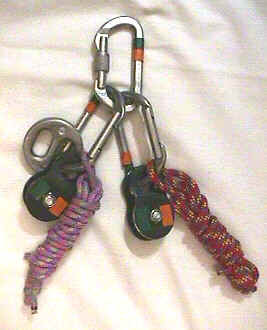
Crevasse Rescue Practice
The West Buttress Route up Denali is considered a technical climb
mainly because most teams travel roped to protect themselves from falling into
crevasses. The theory is that most likely only one person will fall into the
crevasse, and the others can arrest the fall, and pull the victim out if needed. In most
cases of crevasse fall, arresting the fall is enough, and the fallen climber can climb out
unassisted. Sometimes though, the fall can be serious causing an injury and a rescue is
required.
We practiced this rescue process as a team on
two occasions. Once before our training trip to Mount Rainier, and a second time right
before our trip to Denali.
Basically the rescue process involves setting
up solid anchors, then setting up a pulley system to enable the team to pull the fallen
climber out of the crevasse. The pulley system is fairly complicated to set up, and should
be practiced by the entire team. With practice, a team should be able to set up the entire
system in less than 10 minutes. Time can be an important factor in a crevasse rescue,
because the temperatures inside a crevasse can be considerably colder than the surface
temperature of the glacier.
 |
| Crevasse Rescue Pulley System |
The diagram above
shows one way of setting up the pulley system. There are variations, and ways to
improvise. It is good to know and practice one way as a team, and to know ways to
improvise in case the situations warrants.
Knowing the system is one thing, practicing it as a team is another. We found that each person on the rope team has specific responsibilities during the rescue process, and it was good for us to practice at each position on the rope. Detailed steps for each rope position were printed up beforehand and reviewed at the planning meetings.
 |
A rescue can be a very stressful situation, and the last thing you need is confusion as to
how to set up the pulley system. I devised my own way of remembering. I divided the crevasse rescue equipment into 2 parts. Part 1 was the stuff needed for the attachment closest to the victim, and Part 2 was the stuff needed to connect to the anchor. This is how I carried the two parts on my harness: |